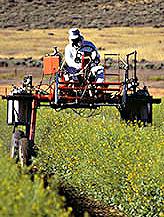Glyphosate Herbicide in Drinking Water Roundup
“Glyphosate is an herbicide that is regulated under the Safe Drinking Water Act. It is an ingredient in Roundup, a widely used herbicide, as well as more than 700 other products for sale in the United States. Glyphosate is a non-selective herbicide used on many food and non-food crops as well as non-crop areas such as roadsides. When applied at lower rates, it serves as a plant growth regulator. The most common uses include control of broadleaf weeds and grasses hay/pasture, soybeans, field corn; ornamental, lawns, turf, forest plantings, greenhouses, and rights-of-way.
Some people who drink water containing glyphosate well in excess of the maximum contaminant level (MCL) for many years could experience problems with their kidneys or reproductive difficulties. This health effects language is not intended to catalog all possible health effects for glyphosate. Rather, it is intended to inform consumers of some of the possible health effects associated with glyphosate in drinking water when the rule was finalized. In 1974, Congress passed the Safe Drinking Water Act. This law requires EPA to determine the level of contaminants in drinking water at which no adverse health effects are likely to occur. These non-enforceable health goals, based solely on possible health risks and exposure over a lifetime with an adequate margin of safety, are called maximum contaminant level goals (MCLG). Contaminants are any physical, chemical, biological or radiological substances or matter in water.
The MCLG for glyphosate is 0.7 mg/L or 700 ppb. EPA has set this level of protection based on the best available science to prevent potential health problems. EPA has set an enforceable regulation for glyphosate, called a maximum contaminant level (MCL), at 0.7 mg/L or 700 ppb. MCLs are set as close to the health goals as possible, considering cost, benefits and the ability of public water systems to detect and remove contaminants using suitable treatment technologies. In this case, the MCL equals the MCLG, because analytical methods or treatment technology do not pose any limitation.
The Phase V Rule, the regulation for glyphosate, became effective in 1994. The Safe Drinking Water Act requires EPA to periodically review the national primary drinking water regulation for each contaminant and revise the regulation, if appropriate. EPA reviewed glyphosate as part of the Six Year Review and determined that the 0.7 mg/L or 700 ppb MCLG and 0.7 mg/L or 700 ppb MCL for glyphosate are still protective of human health.” (EPA 2015)
While the United States classified glyphosate as non-carcinogenic when it was last reviewed in 1993, the World Health Organization published a study in March 2015 that indicates glyphosate is a probable carcinogen. Since the new study was released, there have been many questions asked regarding the safety of glyphosate. According to The Ecologist (June 12, 2015), several countries have banned or restricted use of the weed killer, including France, Columbia, Sri Lanka and El Salvador. In addition, many garden centers across the globe are pulling products that contain glyphosate off their shelves as a precautionary measure to protect customers. However, Roundup remains a staple herbicide in the United States.
Testing for glyphosate previously may have been cost prohibitive for many homeowners. We have partnered with a national testing laboratory to provide a cost-effective alternative that also includes trace metals, volatile organics, and other organic chemicals. For more information, please visit our Testing Testing and Evalatuion Protal but National Testing Laboratories (NTL) now offers a lower-cost test for detecting glyphosate in drinking water. Typical analysis by EPA-approved methods can cost $200 to $400, but the new package offers a much lower price to both water treatment professionals and homeowners.
U.S. Farmers Cope With Roundup-Resistant Weeds
http://www.nytimes.com/2010/05/04/business/energy-environment/04weed.html
Pesticides, Fertilizers Linked to U.S. Premature Births
http://earthhopenetwork.net/Pesticides_Fertilizers_Linked_US_Premature_Births.htm
Pesticides, Fertilizers Linked to U.S. Premature Births
ENS May 7, 2007
INDIANAPOLIS, Indiana
The rising premature birth rate in the United States is associated with increased use of pesticides and fertilizers containing nitrates, according to research by a professor of clinical pediatrics at the Indiana University School of Medicine.Paul Winchester, MD, reports his findings today at the Pediatric Academic Societies’ annual meeting in Toronto, Canada, a combined gathering of the American Pediatric Society, the Society for Pediatric Research, the Ambulatory Pediatric Association, and the American Academy of Pediatrics. “A growing body of evidence suggests that the consequence of prenatal exposure to pesticides and nitrates as well as to other environmental contaminants is detrimental to many outcomes of pregnancy. As a neonatologist, I am seeing a growing number of birth defects, and preterm births, and I think we need to face up to environmental causes,” said Dr. Winchester.
 Dr. Paul Winchester is a professor of clinical pediatrics at the Indiana University School of Medicine and medical director of Newborn Intensive Care Services at St. Francis Hospital, a community hospital in Indianapolis.
Dr. Paul Winchester is a professor of clinical pediatrics at the Indiana University School of Medicine and medical director of Newborn Intensive Care Services at St. Francis Hospital, a community hospital in Indianapolis.
A premature baby is born before the 37th week of pregnancy. Premature birth occurs in between eight to 10 percent of all pregnancies in the United States.The rate of premature birth in the United States has risen about 30 percent between 1981, when the government began tracking premature births, and 2005, according to the National Center for Health Statistics, a division of the Centers for Disease Control and Prevention.
The prematurity rate was 9.4 in 1981; it has increased every year since then except for slight dips in 1992 and 2000.
Winchester and his colleagues found that preterm birth rates peaked when pesticides and nitrates measurements in surface water were highest, from April through July, and were lowest when nitrates and pesticides were lowest, in August and September. More than 27 million U.S. live births were studied from 1996-2002. Preterm birth varied from a high of 12.03 percent in June to a low of 10.44 percent in September.
The highest rate of prematurity, 11.91 percent, occurred in May and June and the lowest, 10.79 percent in August and September. These results were independent of maternal age, race, education, marital status, alcohol or cigarette use, or whether the mother was an urban, suburban or rural resident.
Pesticide and nitrate levels in surface water were also highest in May-June and lowest in August and September, according to the U.S. Geological Survey.
“Preterm births in the United States vary month to month in a recurrent and seasonal manner. Pesticides and nitrates similarly vary seasonally in surface water throughout the U.S. Nitrates and pesticides can disrupt endocrine hormones and nitric oxide pathways in the developing fetus,” Winchester said.
Prema ture baby in an incubator, a controlled safe environment where it can grow until it is functioning independently.
ture baby in an incubator, a controlled safe environment where it can grow until it is functioning independently.
Because they are born too early, premature babies weigh much less than full-term babies. They may have health problems because their organs did not have enough time to develop and need special medical care in a neonatal intensive care unit, where they stay until their organ systems can work on their own.”I believe this work may lay the foundation for some of the most important basic and clinical research, and public health initiatives of our time,” said James Lemons, MD, professor of pediatrics at the IU School of Medicine.
Dr. Lemons is director of the section of neonatal-perinatal medicine at the IU School of Medicine and heads the Riley Hospital for Children of Clarian Health’s section of neonatal-perinatal medicine. “To recognize that what we put into our environment has potential pandemic effects on pregnancy outcome and possibly on child development is a momentous observation, which hopefully will help transform the way humanity cares for its world,” Lemons said. In young infants, ingestion of nitrates, components of fertilizers that are often washed into surface water and groundwater, can reduce the blood’s ability to carry oxygen.
[amazon_link asins=’1514238101′ template=’ProductCarousel’ store=’webdespro-20′ marketplace=’US’ link_id=’224aa70d-d4a5-11e8-85cc-1393b8c39d8f’]
 Today it is possible to minimize fertilizer applications. Mounted on a high-clearance sprayer, this crop canopy sensors monitor plant greenness, which is translated into a signal by an onboard computer that controls the application rate of nitrogen fertilizer to the soil.
Today it is possible to minimize fertilizer applications. Mounted on a high-clearance sprayer, this crop canopy sensors monitor plant greenness, which is translated into a signal by an onboard computer that controls the application rate of nitrogen fertilizer to the soil.
The association between nitrate-contaminated well water and inability of the blood to carry oxygen was first described by Hunter Comly, an Iowa City physician during the early 1940s. In 1974, the Safe Drinking Water Act set a maximum contaminant concentration for nitrates of 10-milligram per liter for public water supplies, but it does not apply to private wells. In a 1994 survey of 5,500 private water supplies in nine Midwestern states, 13 percent of the wells were found to have nitrate concentrations greater than the standard. The state of Wisconsin is well aware of the problems nitrates in drinking water can cause for premature babies, especially in rural areas. In 2006, the state Department of Natural Resources, DNR, issued a warning that nitrates that are washed into groundwater from fertilizer can be dangerous to infants, and especially to premature infants. “All infants less than six months of age are at risk of nitrate toxicity, but premature babies and babies with other health problems are more sensitive than healthy infants,” the DNR said.
Well owners are advised that the only way to know if their drinking water contains nitrate is to have a water sample tested by a certified laboratory. Testing is recommended for well water used by pregnant women and is “essential for a well that serves infants under six months of age,” the DNR says. The state of Indiana Department of Natural Resources does not address this issue.
 At the Yakima Agricultural Research Laboratory in Wapato, Washington, a technician applies a test pesticide to a rapeseed variety being grown for canola oil production.
At the Yakima Agricultural Research Laboratory in Wapato, Washington, a technician applies a test pesticide to a rapeseed variety being grown for canola oil production.
For the past four years, Winchester and colleagues have focused attention on the outcomes of pregnancy in Indiana and the United States in relation to environmental pesticides and nitrates in surface and drinking water. Last year at the Pediatric Academic Societies’ annual meeting, Dr. Winchester reported that birth defects peak in Indiana and in the United States as a whole during April through July, the same months as pesticides and nitrates reach their maximum concentrations in surface water. This year’s presentation expands upon that work. Collaborating with Dr. Winchester on this study were Akosua Boadiwaa Adu-Boahene and Sarah Kosten of the IU School of Medicine, Alex Williamson of the U.S. Geological Survey, and Ying Jun, PhD of the University of Cincinnati. The work was funded by the Division of Neonatology, Department of Pediatrics of the IU School of Medicine.
Glyphosate Testing – RoundUp in Drinking Water
Get Your Drinking Water Tested – Well Water / City Water
